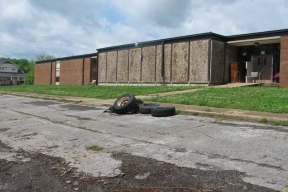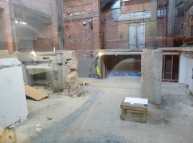Brownfields
The United States Environmental Protection Agency defines Brownfields as real property, the expansion, redevelopment or reuse of which may be complicated by the presence or potential presence of a hazardous substance, pollutant or contaminant. The Tennessee Brownfields Redevelopment Program works with the public to assist in the reuse and revitalization of brownfields in Tennessee. Many properties in Tennessee which were previously used as gas stations, drycleaners, factories or properties that may have contamination from unknown sources qualify as brownfields. Since 1996, the Tennessee Brownfields Redevelopment Program has worked with developers, communities and property owners to bring over 1,700 brownfields properties across the state back into productive reuse.

Where are brownfield sites located in my community?
Why is brownfield redevelopment important?
Why is EPA’s Brownfield Program helpful?
How are brownfield sites investigated?
How to get brownfield grant funding?
What are the benefits of reusing sites?
Government partners
Additional resources
Helpful documents
Where are brownfield sites located in my community?
Generally, brownfield sites exist in a city or town's industrial section, on locations with abandoned factories or commercial buildings, or other former polluting operations. Small brownfields also may be found in many older residential neighborhoods or along rural roads. For example, many dry cleaning establishments or gas stations created high levels of pollution during below the ground their operations and the land they occupy might be unused for decades as a Brownfield. For more information, visit EPA’s Cleanups in My Community Website.
Why is brownfield redevelopment important?
Communities across Tennessee have abandoned places that can be transformed into productive reuses. Brownfield redevelopment transforms blighted properties into sustainable, productive reuses that:
* Use government resources to leverage private investments to meet the combined needs of the community and the marketplace
* Reduce urban sprawl by eliminating barriers to brownfield redevelopment
* Rejuvenating neighborhoods and reducing blight
* Ensuring reuse of existing infrastructure
* Increase local tax bases and property values
* Link economic revitalization with environmental protection
Why is EPA’s Brownfield Program helpful?
The Environmental Protection Agency’s Brownfields Program was designed to empower states, communities, and other groups interested in economic redevelopment to work together in a timely manner to prevent, assess, safely clean up, and sustainably reuse brownfield sites. It is estimated that there are more than 450,000 brownfield sites in the United States. Cleaning up and reinvesting in these properties increases local tax bases, enables job growth, uses existing infrastructure, takes development pressures off undeveloped open land, and both improves and protects the environment.
How are brownfield sites investigated?

Brownfield sites are often investigated by conducting Phase 1 and Phase 2 Environmental Site Assessments. The objectives of these assessments are to gather information on the past use of the site, identify if any environmental investigations have been done, where the contamination is on the site, the type of chemicals present, and if the chemicals present could affect the health of those living nearby or those who may trespass onto the site. Typically, samples of site soil, groundwater, surface water, and air are collected to understand these objectives. Reports of Findings of the Environmental Site Assessments are made available by the local governments to those interested in the sites and to redevelopers who are studying redevelopment potential.
How to get brownfields grant funding?
Initially, EPA provided small amounts of seed money to local governments of affected communities that launched hundreds of two-year brownfield "pilot" projects. Brownfield grants continue to serve as the foundation of EPA's Brownfield Program. These grants support revitalization efforts by providing money for environmental assessment, cleanup, and job training activities. Brownfield Assessment Grants provide money for brownfield inventories, planning, environmental assessments, and community outreach. Brownfield Revolving Loan Fund Grants provide money to capitalize loans that are used to clean up brownfields. Brownfield Cleanup Grants provide direct money for cleanup activities at certain properties with planned green space, recreational, or other nonprofit uses. Brownfield Job Training Grants provide environmental training for residents of communities affected by brownfield sites. Those interested in applying for brownfields money can connect with TDEC’s Brownfields program.
What are the benefits of reusing sites?
Misconceptions about brownfields are among the biggest obstacles to redeveloping these sites. There is a common perception that if a site is contaminated, developers don’t want to have anything to do with it. Educating the public and companies on how to deal with the leftover pollution is vital. Cleaning up one property can lead to ripple effects on other nearby properties. Adjacent or nearby property owners often see the revitalization of one property improving the potential of their property. Benefits include fewer abandoned storefronts, more foot traffic, and more employees staying close to their workplace at lunch, grabbing food or shopping nearby, and an overall increase the vitality of an area. Brownfield redevelopments also put buildings back on the tax rolls. They create tax revenue that otherwise would not be available without the re-establishment of new businesses. Reuse of old buildings can also preserve architectural or historical character. Old buildings are often part of a town’s history and legacy.
Government partners
Agency for Toxic Substances and Disease Registry (ATSDR)
Brownfield/Land Reuse Health Initiative
www.atsdr.cdc.gov/sites/brownfields/overview.html
Land Reuse Healthfields Toolkit
www.atsdr.cdc.gov/sites/brownfields/land_reuse_toolkits.html
U.S. Environmental Protection Agency (EPA)
Brownfields
www.epa.gov/brownfields
Building Vibrant Communities: Community Benefits of Land Revitalization
www.epa.gov/brownfields/brownfields-building-vibrant-communities-community-benefits-land-revitalization
Tennessee Department of Environment and Conservation (TDEC)
Brownfields
www.tn.gov/environment/program-areas/rem-remediation/rem-brownfields-redevelopment-overview.html
Drycleaner Environmental Response Program
www.tn.gov/environment/program-areas/rem-remediation/rem-drycleaning/rem-drycleaning-cleanup-of-contaminated-drycleaner-sites.html
Additional resources
Environmental Law Institute
Brownfields Center
www.eli.org/brownfields-program/brownfields-center
Center for Creative Land Recycling
website
www.cclr.org
Helpful documents